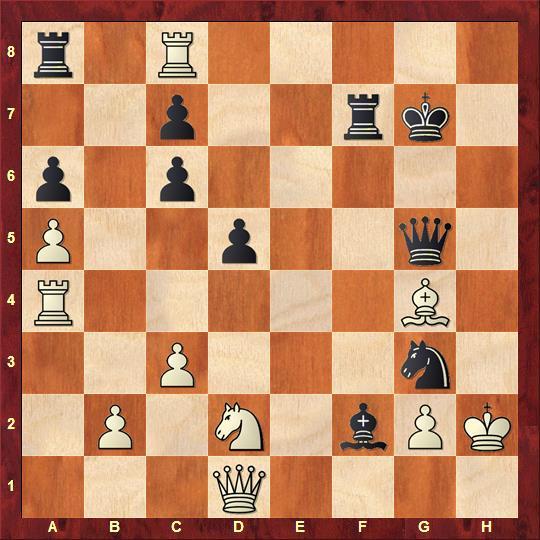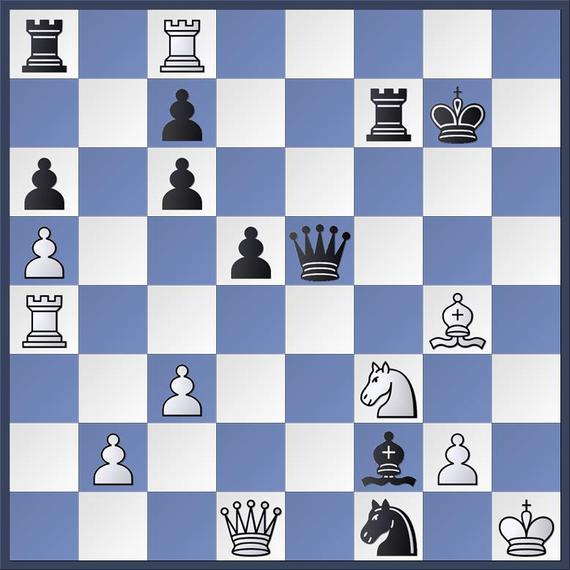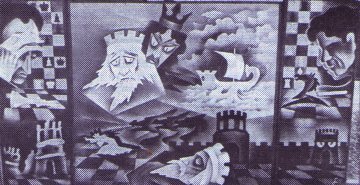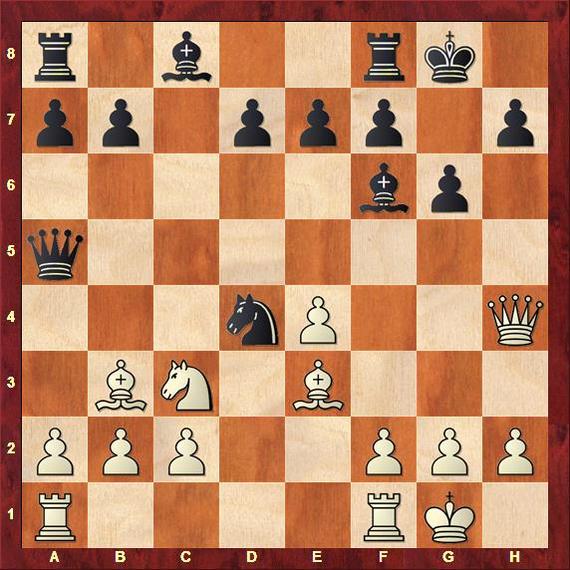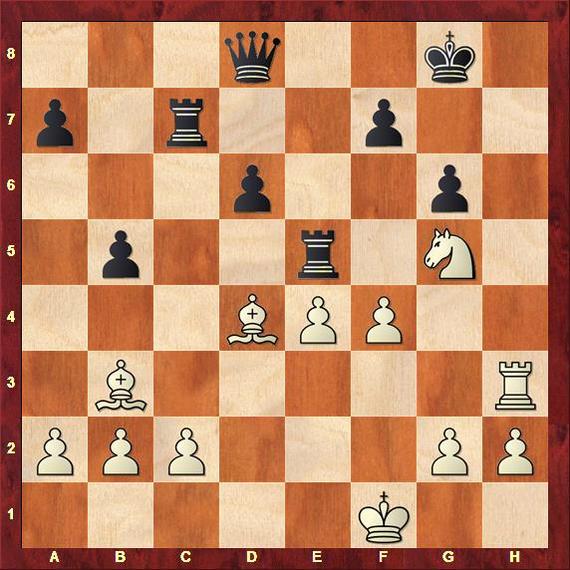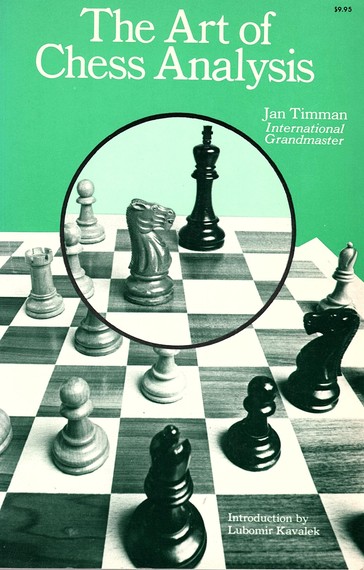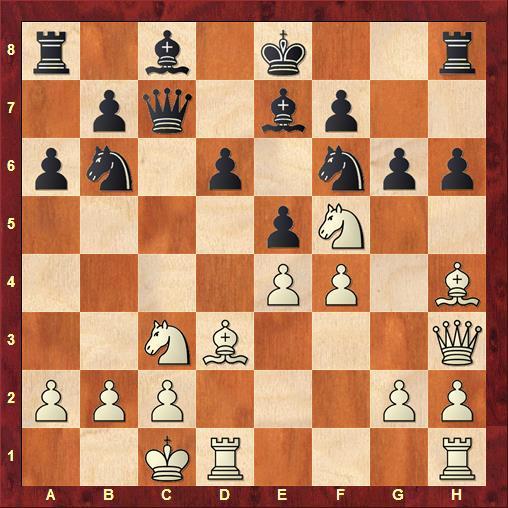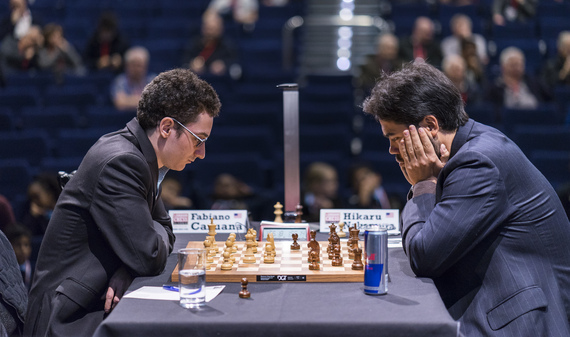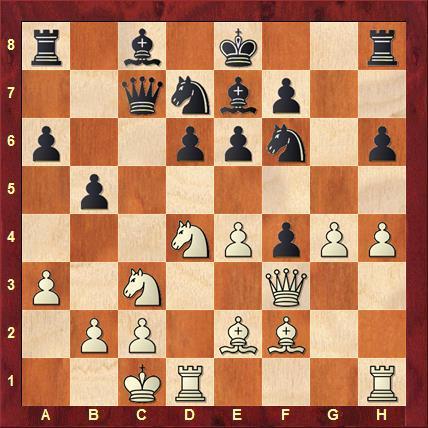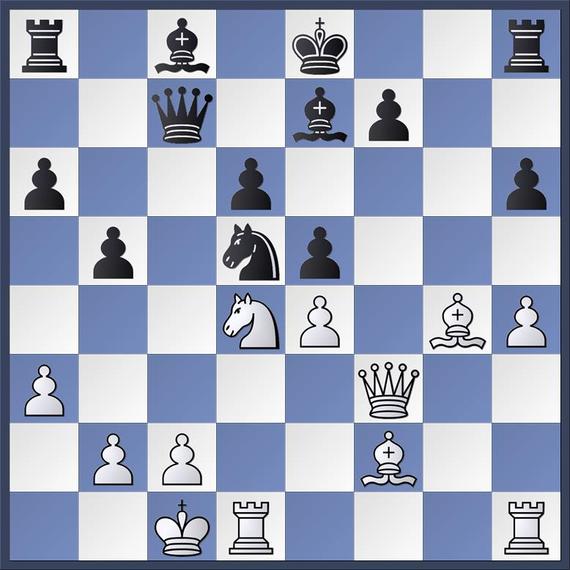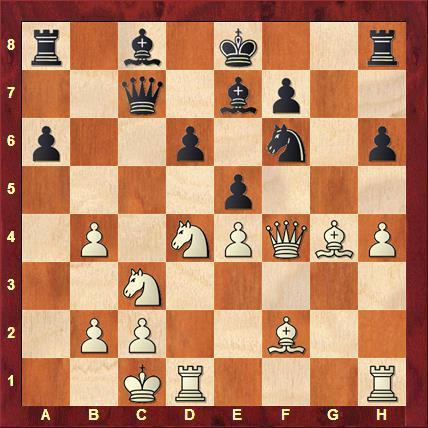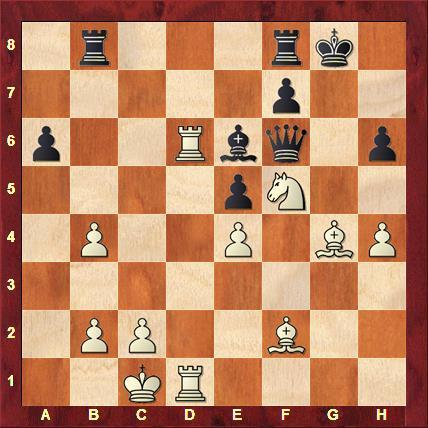When Magnus Carlsen sacrificed his Queen against the Russian challenger Sergey Karjakin last month in New York, it won him not only the world title match, but it was the most brilliant final move of any world chess championship in history. It will be hard to match.
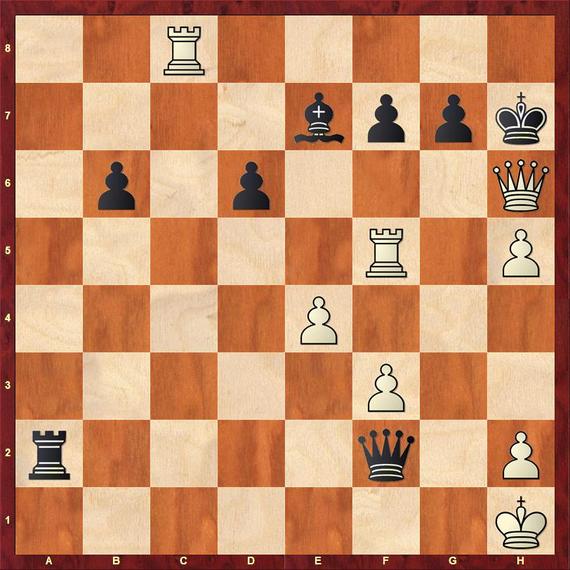
50. Qh6+!! forced Karjakin's resignation.
After 50...Kxh6 51.Rh8 mates, and after 50...gxh6 51.Rxf7 mates.
Chess players are always attracted to Queen sacrifices. They symbolize victory of mind over matter, a desire to do more with less. Some Queen sacrifices are models of efficiency and lead to checkmates; others take advantage of positional deficiencies and bring mysterious twists into chess. Some are waiting to be discovered, stay behind the curtain and never show up. It is always special when these sacrifices are played in games of strong players.
The man in the Barong Tagalog, a ceremonial Philippine shirt, is Wesley So. He won the Grand Chess Tour (GCT) that made him $295,000 richer. According to the former world champion Kramnik, So played the best chess of the year and could be a serious challenger to Carlsen in the future. In the final GCT tournament last month in London, Wesley was prepared to sacrifice his Queen. It led to a spectacular smothered mate, but Veselin Topalov spoiled it a decided to lose differently.
Topalov, Veselin (2760) - So, Wesley (2794)
8th London Classic 2016
Topalov played rather passively and So now brings in his forces for the final attack.
19...f5! 20.exf6 [20.Bh2 g3-+] 20...Nxf6 21.Ra4
After 21.Bxc7 Black has several ways how to win, for example:
A. 21...Kg7 22.Bb6 (22.Qc1 Qh4) 22...Rh8 23.f4 Qh4-+)
B. 21...Rf7 22.Bb6 Rh7 23.Bd3 Rh5 24.Re1 Qh4 25.Kf1 Bxb6 26.axb6 Qh1+ 27.Ke2 Re5+ 28.Ne4 Qxg2-+.
21...Rf7!
Protecting the c-pawn and threatening to swing the Rook to the h-file, Black kills two birds with one stone. Not 21...Nh5 22.Bxg4 Nxg3 23.Bxc8 and White still fights.
22.Re1 Nh5!
Taking advantage of the weak pinned f-pawn.
23.Bxg4 Nxg3 24.Re8+ Kg7 25.Rxc8
After 25.Nf3 Qh6 26.Bh3 Rxf3! wins.
25...Bxf2+ 26.Kh2
26...Qe5!
A precise finish. Black threatens discovery check with the Knight, mating soon.
27.Kh3
So had a beautiful smothered mate in mind after 27.Nf3 Nf1+ 28.Kh1
28...Qh2+!! 29.Nxh2 Ng3 mate.
27...Ne2
The threat is 28...Qg3 mate and after 28.Nf1 Ng1 mates.
White resigned.
Carlsen and So now compete at the Tata Steel Chess tournament in Wijk aan Zee. Lots of nice memories are connected with the Dutch coastal town. In 1975 I won the Leo van Kijk prize for the most spectacular game, offered there for the first time. In the game against the eventual winner Lajos Portisch I sacrificed my Queen for a mere Bishop. But another Queen sacrifice was secretly brewing in the mind of Jan Timman. Well, perhaps not so secretly since we discussed it at the hotel bar, but not in great detail. Timman even mentioned it in the tournament book I wrote about the event. Six months later his sacrifice appeared in our game.
Berry Withuis, a Dutch organizer and journalist, immediately asked: "Do you know Nezhmedtinov's Queen sacrifice?"
I thought he meant Rashid Nezhmedtinov's brilliant masterpiece against Lev Polugaevsky, played in Sochi in 1958. It was one of the best games of the last century and it appeared on a menacing painting of a Russian artist G. Satonina (Nezhmedtinov on the right).
"A different one," said Withuis and made it sound as if Nezhmedtinov created Queen sacrifices every day. He summed it up in a question he asked one day of the legendary grandmaster David Bronstein:
"Is the Queen stronger than two light pieces?"
The former challenger for the world title took the question seriously.
"I don't know," he said. "But I will tell you later."
That evening Bronstein played a simultaneous exhibition in Amsterdam and whenever he could, he sacrificed his Queen for two minor pieces. "Now I know," he told Withuis afterwards. "The Queen is stronger."
In Nezhmedtinov's game the Queen lost, but it was foggy and unclear. Bobby Fischer had a chance, but didn't go there and the computers had later shown that White may equalize at best. It did not deter Nezhmedtinov. He wowed that given a chance, he would sacrifice the Queen again.
Nezhmedtinov,Rashid - Chernikov,Oleg [B35]
Rostov on Don 1963
1.e4 c5 2.Nf3 Nc6 3.d4 cxd4 4.Nxd4 g6 5.Nc3 Bg7 6.Be3 Nf6 7.Bc4 0-0 8.Bb3 Ng4 9.Qxg4 Nxd4 10.Qh4 Qa5 11.0-0 Bf6
12.Qxf6!!
After nearly an hour of deliberation, Nezhmedtinov decided to sacrifice the Queen. Why would he spend so much time on an intuitive sacrifice? He could not calculate it, but he obviously tried. He must have known that Bobby Fischer rejected it a year earlier. After 12.Qg4 d6 13.Qd1 the game Fischer-Reshevsky, Los Angeles 1961, ended in a draw in 25 moves.
12...Ne2+! 13.Nxe2 exf6 14.Nc3
The dark squares can't be defended properly and White's minor pieces get plenty of play. Still, it is roughly equal.
14...Re8
Other options involve the d-pawn.
The violent 14...d5 Nezhmedtinov planned to meet with 15.Bd4!? (15.Nxd5 is, of course, playable, for example 15...Be6 (15...Rd8 16.Bd4 Rxd5?! 17.exd5 Kg7 18.Rfe1±) 16.Nxf6+ Kg7 17.Bd4 Bxb3 18.Ne8+ Kg8 19.Nf6+ Kg7 (19...Kh8?! 20.Ng4+ f6 21.Nxf6 ±) 20.Ne8+=.
Computers suggested the modest 14...d6 15.Nd5 Be6 16.Nxf6+ Kg7 17.Bd4 Rfc8=.
15.Nd5 Re6 16.Bd4 Kg7 17.Rad1= d6 18.Rd3 Bd7 19.Rf3 Bb5 20.Bc3 Qd8 21.Nxf6! Be2 [21...Bxf1 22.Ng4++-] 22.Nxh7+! Kg8 23.Rh3 Re5 24.f4 Bxf1 25.Kxf1! Rc8 26.Bd4 [26.fxe5! dxe5 27.Rd3 Qh4 28.Bxe5! Qxh7 29.Rh3+-] 26...b5 27.Ng5 Rc7
Nezhmedtinov now starts the final combination, reminiscent of the 1966 Petrosian-Spassky 10th game.
28.Bxf7+! Rxf7 29.Rh8+! Kxh8 30.Nxf7+ Kh7 31.Nxd8 Rxe4 32.Nc6 Rxf4+ 33.Ke2 Black resigned.
Timman was under the influence of Mikhail Botvinnik's advice to publish his analysis and to create an analytical debate. He found space in the Dutch magazine Schaakbuletin, founded by Wim Andriessen in 1968.
It was a year of great hopes and disappointments in Czechoslovakia. The Prague Spring, when the Czechs found the freedom to think, speak and write, impacted my chess and I started to have good, consistent results. I finished narrowly behind the winners in Sarajevo, won the all-time strongest Czechoslovakian championship and was able to stay in step with two legends: I won in Amsterdam ahead of Bronstein, but the former world champion Vassily Smyslov edged me in Polanica Zdroj. During the second tournament, the Soviet-led Warsaw pact armies invaded Czechoslovakia and in September I left the country for good.
In November 1968, I won in the Hague, playing Timman for the first time. He was 17, an emerging chess master with plenty of love for the game. I watched his progress as chessplayer and writer with interest. In 1975, when he advertised his queen sacrifice in his writing, he was already a solid grandmaster getting stronger by the day.
Timman,Jan - Kavalek,Lubomir
Amsterdam 1975
12.Bh4?!
This retreat leads to a Queen sacrifice. Discouraged by this game, Timman later in the tournament tried 12.f5 e5 13.Nb3 Bd7 14.Be3! against the Dane Svend Hamman. He won the fight for the control of the d5 square and booked a victory in 29 moves.
12...e5 13.Nf5 g6!?N
A novelty at that time. Walter Browne against Timman (Wijk aan Zee 1975 and later Lajos Portisch against Albin Planinc (Ljubljana-Portoroz 1975) played 13...Bxf5 and both lost. After the text move White is forced to sacrifice his Queen. Of course, Timman knew that I knew about this move, since we briefly discussed it together in Wijk aan Zee, but we did not reach a clear conclusion.
During the game, I remembered a conversation with my friend Milan Vukcevich at the U.S. Championship in Oberlin. Milan tried to convince me that the Queen sacrifice is incorrect, but we did not go into great details.
14.Nxe7?!
The Queen sacrifice is tempting since more white pieces are being offered in the follow up. Some computers suggest 14.Rhe1 gxf5 15.exf5 Kf8 with Black's edge.
14...Bxh3 15.Bxf6 Be6!
Black needs to control the square d5. After 15...Bg4? comes 16.Ned5±.
16.f5 Rf8!?
Stronger than 16...gxf5 17.exf5 Bd7 18.Be4 Rf8 19.Ned5 Nxd5 20.Nxd5 Qa5 21.Nc3=.
17.Bb5+?!
This looks pretty, but grabbing the Bishop first was more prudent: 17.fxe6! fxe6 18.Bb5+! axb5!? 19.Nxb5 Qc5 20.Nxd6+ Qxd6 21.Rxd6 Nc4! Black is better, but White can still fight.
17...Bd7!
The best. 17...axb5?! 18.Nxb5 Qxe7 19.Bxe7 Kxe7 20.fxe6 Nc4 is roughly equal.
18.Ned5 Nxd5 19.Nxd5
This is still Timman's analysis.
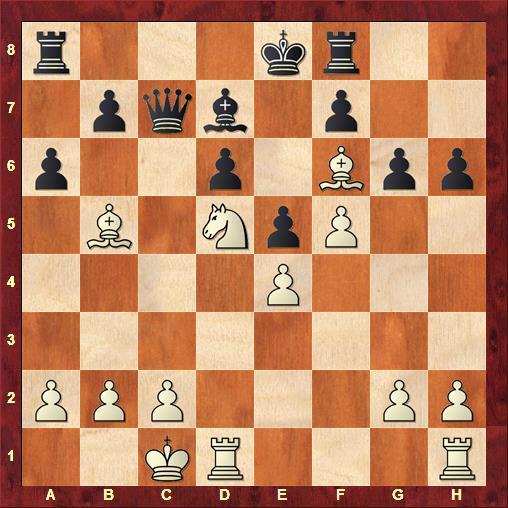
19...Qa5!
This should win for Black, but it is not simple. Timman wrote that after 19...Qc5? 20.b4!White wins, for example 20...Qc8 21.Nb6. Also
after 19...Qb8 20.Bxd7+ Kxd7 21.Rd3 Black's heavy pieces are somehow paralyzed and the chances are unclear.
20.Bxd7+ Kxd7
The material is reduced and Black has more light squares for his Queen.
21.a4
Played after about 15 minutes. White is threatening to win the queen with 22.b4 and Black must allow his Queenside to be tied up.
21...Qc5! 22.b4 Qc6 23.a5
Timman was eager to create an outpost on b6, but it gives Black a time to counter. Black should be winning also after 23.Rhf1 Rac8 24.Rd2 Rg8-+.
23...gxf5! 24.exf5 Rg8
Black finally found an open file for the Rook.
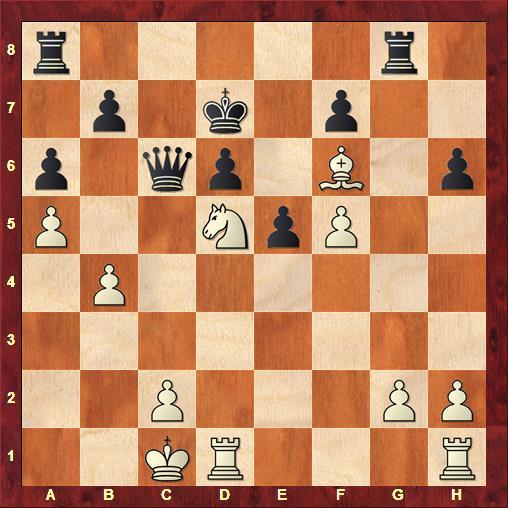
25.Nb6+ Ke8!
Leaving the Rook on a8 unprotected surprised Timman. He was counting mainly on 25...Kc7, but the text move is stronger: Black begins offensive operations.
White has chances to fight after 25...Kc7 26.Nd5+ Kb8? 27.Ne7 Qc3 (27...Qxg2 28.Nxg8 Qxg8 29.Rxd6 Ka7=) 28.Nxg8 Qa3+ 29.Kd2 Qxb4+ 30.Kc1=.
26.g3
The fans did not like this move and preferred 26.g4!?, but Black has a decisive attack after 26...Qc3! 27.Nxa8 (27.h3 Rb8-+) 27...Qa3+ 28.Kd2 Rxg4-+;
Black also wins after 26.Nxa8? Rxg2 27.Rd2 Rxd2 28.Kxd2 Qxh1-+; or
after 26.Rhg1 Rg4 27.Nxa8 Rc4 28.Rd2 Qa4 wins.
26...Rg4!-+
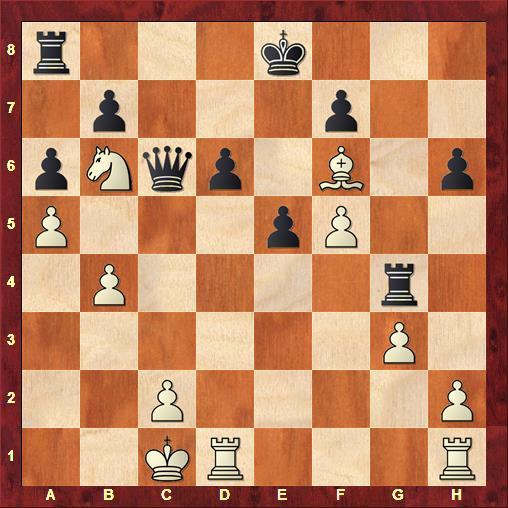
Not wasting time to escape with the Rook on a8. The Queen and the Rook work harmoniously together.
27.Rhe1
After 27.Nxa8 Rc4 the white king is defenseless, although Black has to be careful: 28.Rhe1 Rxc2+ 29.Kb1 Qc4! (But not 29...Qc3? 30.Rxe5+! Kf8 31.Re8+ Kxe8 32.Bxc3+-) 30.Rxe5+ Kf8 and Black mates soon.
27...Rb8 28.Bxe5
Equivalent to resignation, but White really has not much choice, for example:
A. 28.Rxd6 Qxd6 29.Bxe5 Qxb4 30.Bc3+ Qe4-+;
B. 28.Rd3 Rxb4 29.Bxe5 dxe5 30.Rxe5+ Kf8 31.Nd7+ Kg7 32.Nxb8 Qg2 33.Nd7 Rc4-+
28...dxe5 29.Rxe5+ Kf8 30.Nd7+ Kg7 31.f6+ Kh7 32.Nxb8 Qc3! 33.Rdd5
After 33.Re7 Qa1+ 34.Kd2 Rd4+ wins.
33...Rd4!
The final touch, threatening 34...Qa1 mate. Black now gobbles up both Rooks after 33...Rd4! 34.Rxd4 Qa1+ 35.Kd2 Qxd4+ 36.Kc1 Qxe5-+.
White resigned.
In 1984, with the injection of money from the publisher Elsevier, Andriessen turned his magazine into an English publication New In Chess and Timman became editor-in-chief.
Timman's sacrifice didn't turn out as he hoped. Today, it could have been checked by analytical engines beforehand. I don't think Timman considered computers friendly creatures. He was proud to invent ideas on his own.
But computers are here to stay as part of hybrid man-machine preparation. The entertaining Queen sacrifice in the game Caruana - Nakamura, from London last month, is a good example. Nakamura tweaked computer analysis, but it backfired. Caruana's two minor pieces became stronger than the Queen.
Caruana, Fabiano (2823) - Nakamura, Hikaru (2779)
8th London Classic 2016
1.e4 c5 2.Nf3 d6 3.d4 cxd4 4.Nxd4 Nf6 5.Nc3 a6 6.Bg5 e6 7.f4 h6 8.Bh4 Qb6 9.a3 Be7 10.Bf2 Qc7 11.Qf3 Nbd7 12.0-0-0 b5 13.g4 g5 14.h4 gxf4 15.Be2
15...b4?
Nakamura plays a new move, injecting a pawn sacrifice. After the immediate 15...Ne5 16.Qxf4 Nexg4 17.Bxg4 e5 he wants to prevent 18.Nd5!? (The Queen sacrifice 18.Qxf6 Bxf6 19.Nd5 Qd8 20.Nf5 is possible and leads to a roughly equal game. It has been known for several months.) 18...Nxd5 19.Qf3! with White's edge,
for example 19...Bxg4 20.Qxg4 Nf6 21.Qf3 exd4 22.Bxd4±.
16.axb4 Ne5 17.Qxf4 Nexg4 18.Bxg4 e5
19.Qxf6!!
The Queen sacrifice is the only right way to continue and Caruana gets an extra pawn. After 19.Nd5? Nxd5 20.Qf3 Nxb4 Black has an almost decisive advantage.
19...Bxf6 20.Nd5 Qd8
21.Nf5!
This powerful plug, threatening 22.Bb6, is the best move. Two minor pieces for the Queen provide great compensation. White dominates the light squares and open files. There are several variations supporting this view. Nakamura tricked himself or the computer did it. In either case it was a sad ending for his opening preparation.
21...Rb8
After 21...Bxf5 22.Bxf5 Rb8 White can create dangerous threats by marching his c-pawn: 23.c4 0-0 24.c5!+-
22.Nxf6+ Qxf6 23.Rxd6
A human touch. The computers prefer the more forcing 23.Nxd6+ Ke7 (23...Kf8 24.Bf5+-) 24.Bc5! Qf4+ (24...Bxg4 25.Nb5+ Ke6 26.Nc7#) 25.Kb1 Qxg4 26.Nxc8+ Ke8 27.Nd6+ Ke7 28.Nf5+ Ke8 29.Rhg1, threatening 30.Ng7+, White should win.
23...Be6 24.Rhd1 0-0
After 24...Rxb4 25.Rxe6+ fxe6 26.Bh5+ Kf8 27.Bc5+ wins.
25.h5!
A beautiful move, preparing 26.Bh4 to chase the black Queen to the corner square h8.
25...Qg5+
White is better after 25...Rxb4 26.Bh4 Bxf5 27.Bxf6 Bxg4 28.Re1±.
26.Be3 Qf6 27.Nxh6+ Kh8 28.Bf5 Qe7?!
Loses on the spot, but other moves do not save Black either:
A. 28...Qh4 29.Rg1 Qxh5 30.Rdd1 Qf3 31.Rde1+-;
B. 28...Rfe8 29.Rg1+-.
29.b5?!
The immediate 29.Nxf7+! Qxf7 30.Rxe6 would have been more powerful and quicker.
29...Qe8 30.Nxf7+ Rxf7 31.Rxe6 Qxb5 32.Rh6+
After 32...Kg7 33.Rg1+ Kf8 34.Rh8+ Ke7 35.Rxb8 Qxb8 36.Bc5+ wins.
Black resigned.
Note that in the replay windows below you can click either on the arrows under the diagram or on the notation to follow the game. Select games from the dropdown menu below the board.
Images from London Chess Classic and SachInfo




